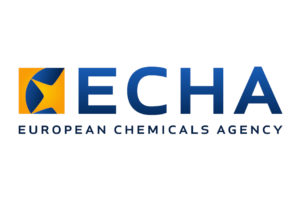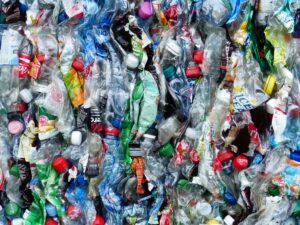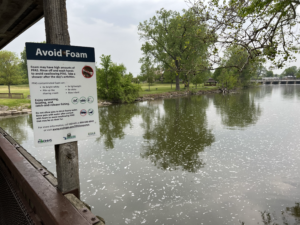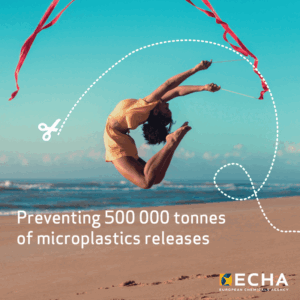News
CEPE calls for smarter regulation to …
… strengthen the EU industry. CEPE (the European Council of the Paint, Printing Ink and Artists’ Colorants Industry) has published a 19-point proposal to reduce regulatory complexity and support innovation in the paint and printing ink sector. The initiative calls for more efficient, but not necessarily less regulation. On May 8, 2025, CEPE published a series of concrete simplification proposals to counteract the growing regulatory burden in the sector. The sector (which employs 100,000 Europeans) warns that the complexity of current EU legislation is hampering innovation, investment and operational efficie- … <Read more>
Could alcohol in disinfectants …
… soon be banned? Will using a bottle of disinfectant become illegal? The common ingredient ethanol protects against bacteria and viruses. But stricter EU regulations could soon make access to them more difficult. Since the Covid pandemic, they have been standard equipment in public restrooms: disinfectant dispensers. They usually contain ethanol. But this could soon be over: an assessment procedure by the European Chemicals Agency (ECHA) is currently underway at the EU level. A panel of experts must assess whether ethanol should … <Read more>
Water-based graph ink for …
… 3D printing. Researchers at the University of Waterloo (Canada) have developed an additive-free, water-based graph ink that offers new possibilities for applications in electronics, the automotive industry and environmental technology. The ink can be processed with 3D printers and offers sustainable solutions for countless technical challenges. Graphene is … <Read more>
Sustainable hybrid coating for …
… the preservation of street art. Protecting street art murals from photo-oxidative, thermal and hydrothermal degradation can be difficult depending on the location and substrate. This article describes the development and characterization of the chitosan-nanosilica hybrid coating. Street art murals are spreading worldwide and transforming urban areas; however, … <Read more>
Improved water-based coatings …
… based on alkyd and amino resins.The mechanical and chemical properties were improved by optimizing the alkyd-amino resin ratio. The methods used combined small-scale test methods and mathematical models. In this study, the curing parameters of the waterborne coating were carefully optimized by using waterborne alkyd resins as matrix resin and fully methyl etherified amino resins as … <Read more>
Polyurethane acrylate improves the …
… elongation recovery of pressure-sensitive adhesives. A new study shows how polyurethane acrylate (PUA) as a crosslinking agent significantly accelerates the stress recovery of pressure-sensitive adhesives (PSA). This opens up new possibilities for flexible electronics. Pressure-sensitive adhesives (PSAs) are important in many industries, including electronics, automotive, healthcare and … <Read more>
ECHA criticizes quality of safety data sheets
The European Chemicals Agency (Echa) has published the results of an EU-wide monitoring operation on the quality of safety data sheets. According to this study, significant deficiencies were found in over a third (35 percent) of safety data sheets. Due to the increased demands, it is absolutely advisable to have safety data sheets drawn up only by qualified personnel or high-quality software. The main … <Read more>
ECS 2025 stands for discovery, connection …
… and innovation! The coatings industry meets in Nuremberg to discuss solutions to today’s challenges. In a few weeks, the European Coatings Show will open its doors to the global coatings family. The leading platform for innovations and trends in the coatings industry took place in Nuremberg from March 25 to 27, 2025. As the industry is facing enormous challenges, visitors and exhibitors can meet innovation leaders and discuss … <Read more>
United EU agencies tackle azole fungicides …
… against Aspergillus fungi. Extensive use of azole fungicides, particularly in some agricultural and horticultural practices, may increase the risk of Aspergillus fungi developing resistance to key antifungal drugs. This finding is highlighted in a report by the EU’s five health and environment agencies with support from the European Commission’s Joint Research Center (JRC). The agencies worked together as part … <Read more>
Discover coating industry innovations …
… during European Coatings Show 2025. Aesthetic, durable, functional and process-resistant: the demands placed on paint and coatings are higher than ever. Decision makers and opinion leaders in the coating industry face major challenges. The European Coatings Show (ECS) 2025 offers the unique opportunity to meet … <Read more>
Potential for improvement in the compliance …
… of safety data sheets. An EU-wide project by ECHA’s Enforcement Forum found that 35% of safety data sheets (SDS) checked were non-compliant. Compliance has improved compared to previous enforcement projects, but further efforts are needed. To further improve the quality of to better protect workers … <Read more>
EFSA recruits scientists for …
…food safety research. On July 1, 2024, 180 leading experts joined the scientific panels of the European Food Safety Authority (EFSA) for a new five-year term. EFSA experts provide independent scientific advice to protect consumers, animals and the environment in the EU. “We are very pleased with the outcome of the panel renewal process and the success of our latest call for applications.” Compared to 2017,… <Read more>
ECHA adds a hazardous chemical to …
… the candidate list. The Candidate List of Substances of Very High Concern (SVHC) now contains 241 entries for chemicals that may be harmful to humans or the environment. Companies are responsible for managing the risks of these chemicals and informing customers and consumers about their safe use. The newly added chemical is bis(α,α-dimethylbenzyl)peroxide. This substance is toxic to … <Read more>
Inspectors check the classification and …
… labeling of mixtures in products. ECHA’s Enforcement Forum has agreed to a new EU-wide project to check that hazardous mixtures in products such as air fresheners or electronic cigarettes are correctly classified, labeled and packaged. The reason is to protect consumers and children from chemical hazards. The purpose of the controls in the new REF-14 project is to protect human … <Read more>
European Commission urges extension …
… of ban on chemicals in medical packaging. International organizations are calling on the European Commission (EC) to ban polyvinyl chloride (PVC) in packaging. Although current restrictions on the harmful chemical are limited to food packaging, environmental rights organization Client Earth stresses the importance of including medical packaging applications in the ban. A report … <Read more>
Research needs for the regulation …
… of hazardous chemicals updated. The European Chemicals Agency (ECHA) has updated its report on the main regulatory challenges. The report now provides more detailed information on the areas where scientific research is needed to protect humans and the environment from hazardous chemicals. More scientific research and method development is needed to further improve the regulation of hazardous chemicals in the … <Read more>
PFAS-free polymer membranes for …
semiconductor processing. Due to their stability and resistance to water and grease, PFAS chemicals are used in a wide variety of industries, but are harmful to health and the environment. For example, membranes containing PFAS are used in many semiconductor manufacturing processes. Researchers at the Fraunhofer IAP have now developed a sustainable alternative in the form of an … <Read more>
How mid-sized companies are …
… preparing for the PFAS ban. Regulatory pressure from the EU and the impact on the sealing industry. The European Union’s initiative, which aims to make Europe the first climate-neutral continent by 2050 and decouple economic growth from resource use, consists of a broad legislative package. This spans numerous regulatory areas, including the PFAS ban, and also has significant implications for the sealing … <Read more>
ECHA optimizes consultations on biocides
Interested parties will soon be able to find out about alternatives to biocidal active substances in one go. Its impact on society and other relevant factors for exemption conditions. This will improve the technical assessment of the conditions under which very hazardous substances can be authorized in the EU. ECHA’s combined external consultation collects information on alternatives to active substances identified … <Read more>
EU member states are missing an opportunity …
… to make toys safer. On May 15, the EU Member States adopted a negotiating mandate to revise the Toys Directive, which does not fully protect children from harmful chemicals. Following the European Parliament’s very ambitious stance earlier this year, the Council’s mandate was not up to the challenge. The member states did not include a group ban on bisphenols and the “eternal chemicals” PFAS, as … <Read more>
The deadline for the PCN transitional arrangement is approaching!
January 2025 marks the end of the transition period for the new harmonized European notifications, PCNs. This means that for every product placed on the European market that meets the requirements of the regulation (more information here), the dossier must be submitted and updated according to the harmonized format in all countries where it is placed on the market. … <Read more>
Joint framework for action between five EU agencies
On May 7, 2024, the European Center for Disease Prevention and Control (ECDC), the European Chemicals Agency (ECHA), the European Environment Agency (EEA), the European Food Safety Authority (EFSA) and the European Medicines Agency (EMA) met to develop a Joint Framework for action to strengthen cooperation to support the implementation of the One Health agenda in the European … <Read more>
Restriction proposal for chromium (VI) extended
The European Commission has asked ECHA to extend the scope of the REACH restriction proposal to at least twelve chromium (VI) substances. ECHA has received an updated mandate from the Commission to prepare a proposal for a possible restriction of chromium (VI) substances. This update complements the original request from September 2023, which targeted two entries currently … <Read more>
Restriction of most harmful chemicals
… to “essential uses” declared. The European Commission has today adopted guiding criteria and principles for the “essential uses” of the most harmful chemicals. The Communication adopted today gives industry and investors predictability on the production of products essential for the green and digital transitions, healthcare and defense in the EU. It is a concrete outcome of the Chemicals Sustainability … <Read more>
EU agencies: More work needed to …
… meetings this spring. The transition to safer and more sustainable chemicals is progressing in some areas, while in others it is only just beginning. This is the conclusion of a first joint European assessment of the causes and consequences of chemical pollution by the European Environment Agency (EEA) and the European Chemicals Agency (ECHA). This review was published today. The benchmarking showed that more work is needed to reduce the impact … <Read more>
New CLP hazard classes in IUCLID
Following the amendment to the Classification, Labeling and Packaging (CLP) Regulation, companies will soon be able to start adding information on new hazard classes to their IUCLID dossiers. April 9, 2024 – The new hazard classes for the classification, labeling and packaging of substances and mixtures will be added to the IUCLID software from April 29, 2024. These are: endocrine disruptors (ED) to human health or the environment; … <Read more>
Highlights of the RAC and SEAC …
… meetings this spring. The Committees for Risk Assessment (RAC) and Socio-Economic Analysis (SEAC) have agreed on twenty opinions on applications for authorization from companies for the use of chromium(VI) substances. Most of these relate to applications in the aerospace and defense sectors. RAC has agreed on 24 and SEAC on 25 draft opinions on applications for authorization and … <Read more>
ECHA’s law enforcement authorities check …
… reports from poison centers. TECHA’s Enforcement Forum is preparing a project to check whether suppliers have reported hazardous chemical mixtures to poison centers. Poison center notifications allow for immediate assistance. The aim of the controls is to protect human health by enforcing the obligation for chemical suppliers to report information on hazardous mixtures to national authorities. National … <Read more>
21st ATP of the CLP Regulation in force!
The 21st ATP of the CLP Regulation adds 28 new entries to the list of hazardous substances and revises the classification of a further 24. The new regulations came into force on January 25, but their application is voluntary until September 5, 2025. The new regulation came into force on January 25, but its application is voluntary until September 5, 2025. The regulation represents the twenty-first adaptation to technical progress (ATP) of the … <Read more>
Next steps for the PFAS restriction …
… for better bee protection! The European Chemicals Agency (ECHA) explains how its two scientific committees will move forward with the evaluation of the proposal to restrict per- and polyfluoroalkyl substances (PFAS) in Europe. After reviewing a large number of comments received during the consultation, ECHA is clarifying the next steps for the PFAS restriction proposal under … <Read more>
ECHA checked 21% of REACH …
… registration dossiers for compliance. The European Chemicals Agency (ECHA) carried out compliance checks on around 15,000 registrations between 2009 and 2023, which corresponds to 21% of complete registrations. This means that the Agency has achieved its legal target for dossier evaluation, which was increased from 5% to 20% in 2019. Of the substances registered … <Read more>
Improved accessibility on the …
… new ECHA CHEM website! The European Chemicals Agency (ECHA) recently launched its latest initiative to optimize the dissemination of chemical information: the new ECHA CHEM website. This platform acts as a comprehensive repository for a wealth of data on chemicals with the aim of providing stakeholders with accessible and up-to-date information. As we delve into the … <Read more>
New ECHA guidelines pave the way …
… for better bee protection! The guidance helps companies and authorities to assess the risks of biocidal active substances and products for bees. It is part of broader EU initiatives aimed at reversing the decline of pollinators by 2030 and preserving biodiversity. ECHA’s guidance provides an approach for assessing the risks of biocides to honey bees, bumble bees … <Read more>
ECHA launches a new chemicals database
ECHA CHEM is a new Agency solution for publishing information on chemicals. The first publication, which is currently available, contains information from all REACH registrations and more will follow. ECHA maintains the largest chemical database in the European Union (EU). This database combines data submitted by industry with information generated through the EU … <Read more>
ECHA adds five hazardous chemicals …
… to the candidate list. The Candidate List of Substances of Very High Concern now contains 240 entries for chemicals that may be harmful to humans or the environment. Companies are responsible for managing the risks of these chemicals and informing customers and consumers about their safe use. The European Chemicals Agency (ECHA) has added five new chemicals … <Read more>
European rivers heavily polluted with PFAS
Are vegetables watered with the water of the Po safe? The question is not as bizarre as it seems, as the Po has been found to be more contaminated with PFAS than the Seine, the Thames and even the Danube. This last river is generally considered to be the most polluted river in Europe. PFAS are chemicals used as components for the most common applications in … <Read more>
Chemical suppliers: Be vigilant …
… against ECHA assessments! A joint recommendation letter is issued for members of the chemical industry on the European Chemicals Agency’s (ECHA) Assessment of Regulatory Need (ARN) reports. Eurometaux, International Fragrance Association (IFRA), FuelsEurope and Downstream Users of Chemicals Coordination Group (DUCC) advise … <Read more>
US and EU authorities investigate PVC
The European Chemicals Agency (ECHA) publishes research findings on polyvinyl chloride (PVC) resin, additives and microparticles. The ECHA believes that the risks of PVC resin are “sufficiently controlled”, but proposes measures against additives and particles. The US Environmental Protection Agency (EPA) is investigating vinyl chloride as a high priority … <Read more>
Do you export to California?
… Then consider Proposition 65! Proposition 65 is a 1986 law that protects California residents from consuming or being exposed to potentially harmful chemicals. More formally, a Proposition 65 warning serves to inform individuals that by using a product or entering a place, they could be exposed to a significant amount of chemicals that could cause cancer, impair infant development, … <Read more>
EU implements groundbreaking…
… legislation against microplastics! The gradual implementation of the regulation will allow companies and industries to gradually adapt to the new requirements. To reduce plastic pollution, the European Union (EU) has adopted new legislation to regulate synthetic polymer microparticles – commonly known as microplastics – with Commission Regulation (EU) 2023/2055. These progressive … <Read more>
Increase in imports of hazardous substances into the EU!
Due to trade in substances containing benzene! The reported volume of hazardous chemicals imported into and out of the European Union (EU) under the Prior Informed Consent (PIC) Regulation has continued to rise sharply in 2022. The European Chemicals Agency’s (ECHA) annual report on trade in chemicals banned or severely restricted in the EU shows that imports … <Read more>
Many consumer products contain…
… hazardous chemicals! An EU-wide enforcement project by the ECHA Forum has identified excessive levels of hazardous chemicals in consumer products. Consider substances such as lead and phthalates. In total, 18% of the products tested were found to be in breach of EU law. National enforcement authorities in 26 EU countries checked more … <Read more>
Every third biocide tested proves …
… to be non-compliant. An EU-wide enforcement project has found around 60 active substances in biocidal products that are not authorized on the EU, EEA and Swiss markets. One in three products tested did not meet at least one of the legal requirements tested. National enforcement authorities in 29 countries tested more than 3,500 biocides. In total, 37% of the biocides tested did not … <Read more>
ECHA identifies research needs for …
… the regulation of hazardous chemicals. The European Chemicals Agency (ECHA) has published a new report on “Key Areas of Regulatory Challenge 2023”, which identifies areas where research is needed to protect people and the environment from hazardous chemicals. It also highlights where new methods are needed to support the move away from animal … <Read more>
ECHA investigations reveal the …
… presence of toxic chemicals in childcare products. The European Chemicals Agency (ECHA) has found that childcare products contain substances that cause cancer, cause genetic mutations or impair reproduction. These include items such as car seats, bibs and changing mats. The research helps the European Commission to prepare an EU-wide restriction … <Read more>
ECHA recommends more transparency …
… in trade in dangerous chemicals. The European Chemicals Agency (ECHA) is recommending changes to the legislative text to improve EU implementation of the Prior Informed Consent (PIC) Regulation, which governs the export and import of hazardous chemicals and pesticides. ECHA’s third report on the functioning of the Prior Informed Consent (PIC) Regulation shows that the overall … <Read more>
Total PFAS ban cripples clean technology!
Opinion! A blanket ban on all types of PFAS (per- and polyfluoroalkyl substances) – or “eternal chemicals” – is currently being considered by the European Chemicals Agency (ECHA). PFAS are used in cleaning products, non-stick cookware, personal care products and more. A ban, therefore, will save lives and create sustainable practices. But according to Daniel Fraile of … <Read more>
No agreement in the EU on …
… the use of glyphosphate! EU member states have failed to reach agreement on the European Commission’s proposed 10-year extension of the use of glyphosate, a controversial chemical used in herbicides. Several member states, including the Netherlands and France, abstained in the Standing Committee on Plants, Animals, Food and Feed (PAFF) on Friday … <Read more>
ECHA to develop restriction proposal …
… for chromium(VI) substances. The European Commission has asked ECHA to prepare a REACH restriction proposal for certain chromium(VI) substances currently on the authorization list of substances of very high concern. ECHA has been asked by the European Commission to prepare an annex. ECHA will submit the proposal by October 4, 2024. The reduction proposal aims to address the challenges posed … <Read more>
The Poison Information Center deadline …
… for mixtures for industrial use only is approaching! It is time for producers, importers and downstream users of mixtures for industrial use only to update their Poison Notification Reports. To fully comply with the harmonized information requirements set out in Annex VIII of the CLP Regulation, it is time for importers and downstream users of mixtures – intended for … <Read more>
Everything you always wanted to …
… know about microplastics … Plastics make our lives easier in many ways and are often lighter or cheaper than alternative materials. However, if not disposed of or recycled properly, they can end up in the environment, where they remain for centuries, breaking down into smaller … <Read more>
More than 5,600 responses to ECHA’s …
… PFAS restriction proposal. More than 4,400 organizations, companies and individuals submitted comments and information on the proposal to restrict per- and polyfluoroalkyl substances (PFAS) in the European Economic Area. By the end of the consultation on Sept. 25, ECHA had received more than 4,400 organizations, companies … <Read more>
RAC proposes to restrict the secondary …
… with latest ECHA data. ECHA’s Committee for Risk Assessment (RAC) supports the French proposal to restrict the placing on the market, reuse and secondary use of wood treated with creosote and related substances. The draft opinion of the Socio-Economic Analysis Committee (SEAC) is open for comments until November 7, 2023. On the recommendation of France, the RAC concluded … <Read more>
Poison control centers and update requirement?
Notices are required to keep submitted information up to date at all times. Existing notices may need to be updated. Relevant changes leading to the update obligation are described in Annex VIII of the CLP Regulation. CLP Article 45 and Annex VIII require all economic operators placing mixtures with health or physical hazards on the market in the EU – including Norway, Iceland and … <Read more>
OECD eChemPortal updated with …
… with latest ECHA data. Data on more than 1.3 million endpoints for 27,000 substances registered with ECHA under REACH are now available on the OECD eChemPortal. The updated information includes more than 186 new substances from ECHA’s REACH registration database, bringing the total number to 26,673 substance records. In addition, 18207 endpoint records have been added for all substances, bringing the total to … <Read more>
35 Hazardous Chemicals Added to …
… Prior Informed Consent (PIC). ECIA’s Global Industry Practices Committee (GIPC), in collaboration with other industry associations, is urging companies in the authorized electronic components channel to go directly to the ECHA website, submit expert comments and request exemptions from the upcoming REACH restrictions on PFAS in Europe. The latter, of course, if needed. Germany, the Netherlands, … <Read more>
New task for ECHA to make batteries safer …
ECHA will assist the European Commission in identifying substances of concern contained in batteries or used in their manufacture. It will also develop proposals to limit substances in batteries. The goal is to make batteries in the European Economic Area (EEA) more sustainable throughout their life cycle. With the modernization of the EU battery regulatory framework, ECHA has been … <Read more>
ECIA warns against REACH restriction on PFASs
ECIA’s Global Industry Practices Committee (GIPC), in collaboration with other industry associations, is urging companies in the authorized electronic components channel to go directly to the ECHA website, submit expert comments and request exemptions from the upcoming REACH restrictions on PFAS in Europe. The latter, of course, if needed. Germany, the Netherlands, … <Read more>
EU-wide PFAS ban in firefighting …
… foam justified! ECHA’s Socio-Economic Analysis Committee (SEAC) has issued its final opinion in support of a phase-out ban on per- and polyfluoroalkyl substances (PFAS) in firefighting foam. The mitigation could reduce PFAS emissions to the environment by approximately 13,200 tons over a 30-year period. SEAC believes that the proposed restriction on the … <Read more>
New EU project to enforce …
… chemicals in products offered online. ECHA’s Enforcement Forum agreed to launch an EU-wide project to verify whether products offered online comply with REACH restrictions and the requirements of the Classification, Labeling and Packaging (CLP) Regulation. The Biocidal Products Regulation Subgroup (BPRS) agreed to launch a project on biocidal … <Read more>
When should you update or …
… revise your safety data sheets (SDS)? A look at the regulatory requirements for SDS updates in the major countries that have adopted GHS. Understanding legal requirements in countries that have adopted GHS Introduction: Chemical suppliers must periodically review and update their SDSs to include new hazard information, protective measures, … <Read more>
Highlights from the June BPC meeting
ECHA’s Biocidal Products Committee (BPC) believes that it is not possible to differentiate the risk profiles of substances used as anticoagulant rodenticides (AVCs). With this conclusion, the Committee concludes its opinion on the second comparative assessment of anticoagulant rodenticides. At its June 5-8 meeting, the BPC adopted its opinion on a final question … <Read more>
ECHA workshop paves way for …
… regulations on non-animal chemicals. More than 500 participants attended ECHA’s workshop on new approach methods (NAMs) to discuss options. With the goal of replacing animal testing in the risk assessment of industrial chemicals while ensuring a high level of protection for human health and the environment. The goal of the May 31-June 1 workshop was to gain a common understanding of what NAMs can accomplish in the short and long term. Participants discussed potential areas where NAMs could be used to reduce regulatory reliance on animal test data and and how to accelerate their … <Read more>
ECHA sees widespread use of …
… alternatives to chemical safety assessment. The report shows that more are still being used than competitions, with analogy being the most likely option. In vitro testing methods that do not involve animals have been on the rise in recent years. The European Chemicals Agency (ECHA) has published its fifth report on the use of alternatives to animal testing on the REACH regulation. The report suggests that progress is being made through the dual use of alternatives to collect data on the properties of substances rather than animal … <Read more>
IUCLID updated with new …
… for which the reduced information requirements do not apply. The latest update to the International Uniform Chemical Information Database (IUCLID) reflects the revised information requirements for the registration of chemicals under REACH. The updated formats and completeness checking rules help companies report on compliance with REACH requirements. Helsinki, May 22, 2023 – In 2021 and 2022, the European Commission clarified the REACH information requirements (Annexes VI to XI), further improving the safety and management … <Read more>
Publication data on the development …
… of alternative methods for animal testing. EFPIA and ECHA recently published additional information on the hazardous properties of 75 substances from 370 tests as IUCLID datasets. This more than doubles the amount of data originally available to the scientific community developing alternative test methods when the joint initiative began a year ago. A pilot project led by the European Federation of Pharmaceutical Industries and Associations (EFPIA) – supported by ECHA – has made … <Read more>
ECHA removes the list of substances …
… for which the reduced information requirements do not apply. The list of substances expected to meet the criteria of Annex III of REACH has been removed from ECHA’s website. The list was created in 2016 to help registrants interpret the REACH Annex III criteria when preparing their registrations for the 2018 registration deadline. Since the deadline has passed and new information or predictive methods may have emerged since then, ECHA has decided … <Read more>
ECHA advises on new hazard classes …
… for substances and mixtures. On April 20, 2023, three new hazard classes for the classification, labeling and packaging (CLP) of substances and mixtures will enter into force. ECHA has published information on application dates and related guidance. The hazard classes in sequence. The European Commission has updated the Classification, Labeling and Packaging Regulation with the following hazard classes: Endocrine disruptors (EDs) to human health … <Read more>
Approval of active substances
Active substances must be approved before an authorization can be granted for a biocidal product containing them. Active substances are first evaluated by an evaluating competent authority of a Member State. The results of these evaluations are forwarded to ECHA’s Biocidal Products Committee, which issues an opinion within 270 days. The opinion serves as the basis for the authorization decision, which is made by the European Commision. … <Read more>
ECHA Recommends Eight Substances …
… for REACH Authorization. To protect workers and the environment, ECHA is recommending that the European Commission add eight substances to the REACH authorization list. Lead is one of these substances. Once substances are added to the list, companies must apply for authorization to continue using them. ECHA’s 11th recommendation includes the following substances: Ethylenediamine; 2-(4-tert-butylbenzyl)propionaldehyde and its individual stereoisomers; … <Read more>
The next IUCLID release has been postponed to May 22nd
The next IUCLID release will include format changes and additional enhancements. The original release date was May 24. The new release date is May 22. The IUCLID team is currently working on the next IUCLID version. Over the past few months, the format changes and associated migration, as well as additional enhancements to the IUCLID software, have been implemented. However, in order to deliver the agreed … <Read more>
ECHA reviews one-generation reproductive …
… and polymers guidelines. In a review of 55 extended one-generation reproductive toxicity studies (EOGRTs), ECHA confirms their effectiveness in identifying substances of concern. Since their introduction as a REACH information requirement in 2015, EOGRT studies have proven effective in identifying substances of concern. The studies help clarify whether a substance has adverse effects on sexual … <Read more>
European Coatings Show 2023: …
… Face to Face in Nürnberg! After a long period of uncertainty, the prospects are now good for another edition of the Europea Coatings Show (ECS), which will be held as a face-to-face event in Nuremberg from March 28-30, 2023. The Coronavirus has had a deep impact on the whole world and on-site trade shows have not been possible for a long time. Now the prospects are good for a new edition of the European … <Read more>
ECHA identifies certain brominated flame …
… and polymers guidelines. ECHA has published its regulatory strategy for flame retardants. It identifies aromatic brominated flame retardants as candidates for EU-wide restriction. This would minimize human and environmental exposure to these persistent, potentially bioaccumulative and toxic substances. Persistent in the environment and potentially toxic. Aromatic brominated … <Read more>
CLP EU vs. UK: What’s different …
… and what can we expect? Pending a full review of the EU CLP regulation before 2024, both regulations will continue to expand. When Brexit occurred three years ago, it impacted the regulatory relationship between the UK and the rest of Europe. For example, the CLP Regulation was transposed into UK law after Brexit. Importantly, the alignment of the CLP Regulation with UK territory has led to differences in hazard classification, … <Read more>
Authorities and ECHA insist on …
… compliance with authorisation obligations. The Enforcement Forum’s EU-wide project to review REACH authorisation obligations has found that the majority of users – mainly small and medium-sized enterprises – already comply with the risk management authorisation obligation. Enforcement actions by authorities during the project are aimed at getting companies to comply. During this project, enforcement officials … <Read more>
ECHA is updating monomers …
… and polymers guidelines. The decision of the Board of Appeal affected registration requirements for importers and measurements of monomers and polymers. On 29 June 2021, ECHA’s Board of Appeal (BoA) issued a decision on an audit audit (A-001-2020) regarding registration obligations for polymer importers. ECHA’s Guidance on Monomers and Polymers is being revised to coincide with … <Read more>
New pharmaceutical IUCLID datasets …
… support alternatives to animal testing. ECHA has published structured datasets in IUCLID for 348 approved pharmaceuticals with results from nonclinical animal studies and information on humans. The new datasets provide robust pharmaceutical information for industry and researchers in a structured format. They support toxicity assessment of structurally similar chemicals with the … <Read more>
ECHA adds 9 chemicals to REACH SVHC list
What does it mean for you? On Jan. 17, 2023, the European Chemicals Agency (ECHA) added nine additional substances to the candidate list under Regulation (EC) 1907/2006 on the Registration, Evaluation, Authorization and Restriction of Chemicals (REACH). The chemicals are placed on ECHA’s candidate list if they are: carcinogenic, mutagenic and and toxic to reproduction (category 1A or 1B); … <Read more>
European PFAS ban moves closer
he Netherlands, Denmark, Germany, Norway and Sweden have submitted a proposal to the European Chemicals Agency (ECHA) to ban the production, marketing and use of PFAS. The ban on PFASs should be included in the European Union’s REACH regulation on chemical substances. ECHA will publish the detailed proposal, one of the most comprehensive in EU … <Read more>
ECHA wants evaluation of potentially …
… hazardous cosmetic substances for CoRAP 2023 to 2025. Jan. 10, 2023 – The European Chemicals Agency (ECHA) has published the draft Community rolling action plan (CoRAP) consisting of 24 substances suspected of posing a risk to human health or the environment. Seven cosmetic ingredients have yet to be assessed. The cosmetic substances of concern are sodium benzotriazolylbutyl- … <Read more>
Reported trade of hazardous chemicals …
Die gemeldete Menge von Chemikalien, die gemäß der Verordnung über die vorherige Zustimmung nach Informierung (PIC) aus der Europäischen Union (EU) exportiert und in diese importiert werden, ist im Jahr 2021 erheblich gestiegen, was hauptsächlich auf den Austritt des Vereinigten Königreichs zurückzuführen ist. Der jüngste Jahresbericht der ECHA über … <Read more>
Which chemicals are of concern?
Any chemical that can cause harm is considered hazardous. Certain chemicals can cause all sorts of damage ranging from mild skin irritation to cancer. They can also have a significant impact on the environment, i.e. air, water and soil, and affect plants and animals. A chemical can only harm our health or the environment if we are exposed to it. To protect ourselves from hazardous chemicals, we need to make sure … <Read more>
Is titanium dioxide carcinogenic or not?
Since October 2021, titanium dioxide must be warned that it may be carcinogenic by inhalation. The European Court of Justice has now declared this classification invalid because this is not yet completely clear for this substance. On November 23, 2022, the European Court of Justice (ECJ) declared that titanium dioxide had been wrongly classified as a carcinogen by inhalation. The court annulled the corres- … <Read more>
ECHA opens consultation on hazards
A consultation on the harmonized classification and labeling of tea tree, Melaleuca alternifolia extract and essential oil has been submitted by Poland to the European Chemicals Agency (ECHA) for review. The country has submitted a proposal highlighting the hazardous effects of tea tree oil (TTO) on human health and toxic effects on aquatic life. Those with relevant … <Read more>
Rodent traps can be effective …
… in combating house mouse infestations. ECHA’s Biocidal Products Committee (BPC) considers that mechanical traps are suitable alternatives to anticoagulants for controlling indoor mouse infestations. However, their effectiveness is uncertain for other applications and target animals such as rats. The Committee also considered … <Read more>
Need help meeting Japan’s new SDS requirements?
New Code of Practice published! 234 new substances subject to mandatory SDS and labeling requirements under ISHL. The Japan Chemical Industry Association (JCIA) has published a guidance document to help companies comply with new SDS and labeling requirements under the revised ISHL. Although not an official document, it is considered “a high reference” because it was … <Read more>
Update of the ATEX regulations
The standards apply to working environments where there is a particular risk of explosion! To provide clarity, the European Commission has decided to publish in one law/document the new list of harmonized measures for equipment and protective systems in potentially explosive environments. Commission Implementing Decision (EU) 2022/1668 of 28 September 2022 establishes new harmonized … <Read more>
REACH revision postponed under pressure from industry
Industry associations are putting pressure on European Commission members. Now the EU chemicals regulation REACH will not be revised – or not implemented at all – until the end of 2023. This could have major consequences for people and the environment. Business associations prevailed, the European Commission conceded. It has delayed the urgently needed revision of the previous … <Read more>
Banning PFAS in firefighting foams

ECHA is submitting a proposal to restrict all per- and polyfluoroalkyl substances (PFASs) in firefighting foams. Firefighting foams containing PFASs have caused many cases of environmental contamination in the EU. Both in soil and in drinking water. All PFASs or their breakdown products are highly persistent and some are known to cause harm to human health or the environment. … <Read more>
SIAM acquires full ownership of …

LABORATORIOS ALMABE IDUQC in Murcia … As part of SIAM’s strategic growth and diversification plan, we have acquired ownership of LABORATORIOS ALMABE IDUQC. The acquisition concerns an independent laboratory founded in 2012 and located in the Murcia Science and Technology Park. LABORATORIOS ALMABE IDUQC provides analysis, physicochemical … <Read more>
EU regulations ban tattoo ink from January

The needle buzzes, the pain is irritating and at the end a dazzlingly colorful bird radiates from the freshly tattooed skin. Tattoos and the people who wear them are no longer uncommon. Whether simple symbols or slogans in the classic black-grey style, ie only in black, or colorful motifs that dance up and down the color palette. However, from January it can become quite drab … <Read more>
ECHA steps on the brakes

Risk Assessment Committee asked to consider new information on microplastics. Against expectations, in February the European Chemicals Agency (ECHA) chose not to submit the opinion of its two subcommittees on microplastics to the European Commission for the time being. Why not and what does this mean for the future? When ECHA announced in mid-December that the Committee … <Read more>
ECHA imposes restrictions on the use of lead for …

… outdoor shooting and fishing. The European Chemicals Agency proposes further EU-wide restrictions on the use of lead in hunting and outdoor target shooting and fishing ammunition. The proposal aims to address the risks posed by lead in these activities in order to protect people, wildlife and the environment. At the request of the European Commission, … <Read more>
ECHA: Review of material registrations from UK suppliers

The European Chemicals Agency has asked European companies to check the substance registrations of their UK suppliers to ensure that these materials are also listed in the section for the EU and the European Economic Area (EEA). The transition period for Great Britain to leave the EU ends on … <Read more>
New EU database for pollutants from 2021:

Impulses for recycling management. ‘From January 5, 2021, information about products containing substances of very high concern that are placed on the EU market must be reported to the European Chemicals Agency,’ said environmental expert Axel Dick and occupational … <Read more>
Information and assistance with Brexit

The European Chemicals Agency (ECHA) is updating its IT tools and information on the UK’s departure from the EU. ECHA has updated its IT tools and information on the internet on the UK’s withdrawal from the EU. Includes questions and answers with advice for companies. End of transition period … <Read more>
The UK chemical industry is very concerned about the additional costs of Brexit

Since 2007, European chemical companies have been carefully building an extensive substance database at the European Chemicals Agency (ECHA) in Helsinki, in which all substances used in the EU are registered. There are fears that some chemicals that are still available today … <Read more>






















































































